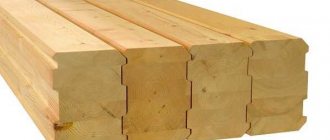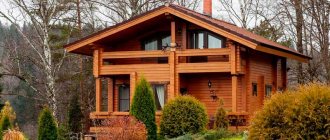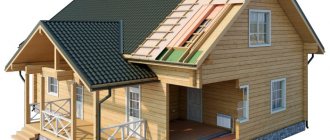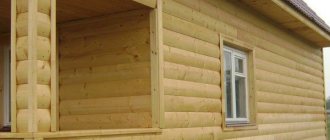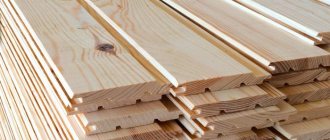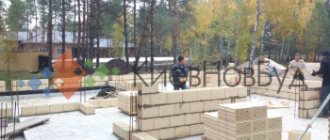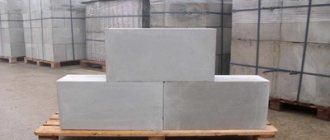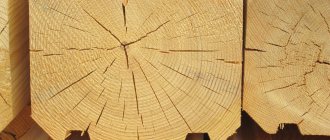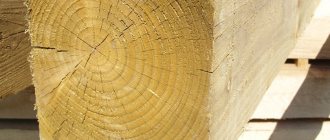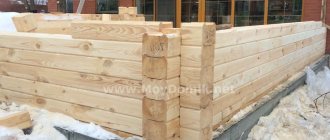What is profiled timber?
This modern lumber is made using industrial equipment. During production, it is subjected to several types of processing, resulting in the wood acquiring its final shape and unique characteristics.
The production of profiled timber is mainly carried out from the following types of wood:
- pine;
- spruce;
- cedar;
- aspen;
- larch.
In private housing construction, pine is usually used, as it is cheaper. Baths made of profiled timber are often built from cedar or aspen. Both breeds tolerate temperature fluctuations and high humidity well. Larch has a long service life, but is expensive.
Spruce is considered the least preferable. It is susceptible to rotting, but has a beautiful appearance, so it is used mainly for internal partitions and decoration.
An important feature of profiled timber is the presence of a profile, which is located on both sides. This element provides good fixation and reduces the number of blown zones in the wall. In addition, the profile speeds up the construction of the building and allows you to save on insulation.
Production is carried out in accordance with GOSTs (8486-86, 8242-88, 24454-80, 11047-90). State standards establish technical requirements for lumber intended for construction.
Manufacturing of profiled timber
It happens in several stages:
- Selection of wood. This stage determines the future characteristics of the product.
- Selection of section. The market offers square, rectangular and rounded sides.
- Rejection. Lumber with defects is removed.
- Calibration The remaining ones are grouped depending on size.
- Drying – natural or chamber. Natural drying takes several months, chamber drying - 2-4 weeks.
- Some manufacturers at this stage saw the material so that it does not crack, and treat it with antiseptics and fire retardants.
- The lumber is then planed and profiled.
Tongue and groove profile
The locking connection has two tenons located at the edges of the beam and a groove between them. The profile ensures a tight fit of adjacent crowns, which helps prevent the walls from blowing even when gaps form after shrinkage of the wood.
Unlike the German profile, timber with a tongue-and-groove connection requires insulation. It provides protection from blowing if, when the building shrinks, gaps appear between the crowns.
The advantages of the tongue-and-groove connection are the ease of assembly of the timber. Moreover, if necessary, the erected structure can be easily disassembled.
Pros and cons of profiled timber
Main advantages
Profiled timber has many advantages compared to other materials:
- attractive appearance (houses made from it do not require additional finishing);
- ecologically pure;
- low thermal conductivity, allows you to reduce the cost of heating your home;
- there is no need to seal the walls, since the crowns fit tightly to each other;
- high strength;
- treated with agents against fungi, mold and fire;
- maintains original dimensions;
- ease of assembly;
- quick installation;
- long service life;
- does not crack;
- after assembling a log house from dried profiled timber, slight shrinkage of the house occurs;
- the house is lighter than other materials, so it does not require a massive foundation. Can be installed on a columnar or strip foundation.
Disadvantages of profiled timber
Profiled timber has several disadvantages:
- Frequent manufacturing defects.
- Profile defects are often encountered.
- It is not always sufficiently dried, as a result of which the shrinkage period increases.
- High flammability. Requires compliance with fire safety standards and requires special treatment.
- The need for additional insulation. It occurs when the thickness does not correspond to climatic conditions or the construction technology is not followed.
- Wood darkens over time.
- After construction is completed, it is difficult to change the layout of the premises.
Mistakes when building from profiled timber
Violations of construction technology and errors when working with this material include:
• Insufficient depth of strip foundations and errors in calculating the bearing capacity of supports. Particular attention in this regard requires areas with heaving soils, which raise weak strips along with the walls of the building by 20-40 cm during periods of freezing.
• Lack of a waterproofing layer between the tape or grillage and the lower row of beams, low height of the plinth or foundation piping in frequently flooded areas. Advice! Make a backing board from larch so that your log house will serve for a long time, and it is better to frame the foundation with larch silt, under the first row of timber.
• Weak inter-crown insulation . Many developers, in order to save money, lay only 1 layer of tape insulation between the grooves instead of the recommended 2-3, which subsequently leads to unnecessary costs for caulking and heat loss.
• Excessive tight connection of adjacent beams at joints and corners. The absence of internal compensation gaps is fraught with ruptures of wood due to swelling from dampness or thermal expansion.
• Assembling a log house using metal pins or even worse, using nails (this is generally on the verge of good and evil). Yes, it’s easier on the studs, it seems like I twisted the studs and compensated for the initial shrinkage processes. But this is a marketing ploy, wood is constantly affected by temperature and humidity, condensation will form on the heels in cold weather and the formation of mold and mildew will begin, and these are additional cold bridges around the entire perimeter of the house. It is necessary to assemble wooden buildings on dry dowels treated with an antiseptic!
• Laying vertical walls without level control . Eliminating this error is possible, but this process takes a lot of effort and money.
• Ignoring the need for antiseptic protection of freshly sawn ends. Almost all modern lumber is supplied in a form treated with antiseptics, and inexperienced developers forget about the need to impregnate cross cuts and corner grooves or postpone this work.
• Excessive caution when settling the crowns of buildings, leading to the formation of large cracks.
• Errors in determining the size and location of door and window openings , ignoring the need to strengthen structures in these areas.
• Reducing the pause time before finishing work and erection of the main roof, eliminating the installation of a temporary roof and protecting cracks during the shrinkage period.
• Savings on varnishes and protective agents.
Advice! Design errors pose a particular danger. When building from profiled timber, try not to use balconies, canopies and verandas in planning decisions; these are the weakest elements in structural terms. If you want a veranda, then it must be built separately from the house using the method of floating attachment to the house.
It is extremely difficult to make changes to the layout after assembly; poor decisions, such as scattering areas with high humidity throughout the house or incorrectly located openings, are expensive. The same applies to errors in the calculation of foundation and roof structures.
Types of profiled timber
Classification is carried out according to the following characteristics:
- front side view;
- dimensions;
- profile type;
- type of drying;
- structure.
Front side view
She may be:
- Straightforward. The most popular is timber with straight sides. This form is convenient for subsequent wall finishing; it is the cheapest.
2. D-shaped. The outer side has a curved shape, like a rounded log, while the inner side is straight. A house made of such lumber does not require additional external finishing.
3. O-shaped. The most expensive type. With this profile, you don’t have to do any cladding either inside or outside the house.
Size of profiled timber
Typically, the thickness of the timber for external walls is from 100 to 200 mm.
The most common sizes (mm): 100x100, 150x150 and 150x200.
For houses built according to individual projects, manufacturers produce products with dimensions that correspond to the features of a particular structure.
The area of use depends on the thickness of the material. 100 mm timber is used for light buildings (gazebos, cottages) or internal partitions. A thickness of 150 mm is suitable for residential buildings, and 200 mm is used for the construction of expensive cottages.
Profile type
Profiled timber is available with the following types of profiles:
- Single-spike. The presence of one ridge eliminates the possibility of water accumulation at the joint. Characteristic for naturally drying materials.
- Double (two-spike). This type provides a more secure hold. Thanks to two spikes, thermal insulation is increased.
- Multiple (comb). This type has from 3 to 8 spines. Compared to other types, the comb provides the most reliable fastening and maximum thermal insulation.
- Beveled chamfers. This type is one of the varieties of double profiles. Due to the beveled chamfers, less water accumulates at the attachment point, making caulking of the walls easier.
- Finnish (Scandinavian) type, which has two ridges with beveled chamfers, located at a large distance from each other.
In this case, the profiled timber can be either glued or ordinary.
Timber drying type
Materials highlighted:
- natural drying;
- chamber-drying profiled timber.
Moisture content determines the performance characteristics of the material.
The first type of timber is dried naturally. Lumber is laid in a place protected from water and sun so that air circulates between them. To achieve the desired level of humidity, the products are aged for several months. The disadvantage of this method is long drying and shrinkage.
When chamber drying, the workpieces are placed in special chambers - ovens, which reduces production time. This material is more expensive, but shrinkage occurs quickly and is very small.
After drying is complete, the wood retains a certain amount of moisture. Material that has undergone natural drying has a moisture content from 22% to 40%. When chamber drying - 18-20%.
Profiled timber: price
To make profiled timber, much more time and skill is required. You also need special professional equipment and the ability to handle it.
It is logical that such material is noticeably more expensive than simple smooth material, even if it is processed. But the profile significantly simplifies construction. The walls fold up like a construction set, saving labor and time. Less insulation required.
Dry profiled solid timber is usually 30% cheaper than laminated timber. This is due to the peculiarities of the technologies used to create products. In the case of laminated veneer lumber, the buyer is freed from the need to additionally sand the facade before starting painting. This allows you to save on costs.
The cost of finished houses is approximately the same for both types of materials. Therefore, the choice is made precisely on the basis of operational characteristics.
When purchasing, it is important not to skimp on really high-quality wood, harvested according to all the rules. There are cases when an unscrupulous manufacturer neglects technology in order to save money. It is better to purchase profiled timber from a well-established manufacturer.
Dimensions
Among the main characteristics of profiled timber are the dimensions. This characteristic directly affects the construction of the house. The thickness of the timber varies from 100 to 200. The standard section corresponds to - from 100x100 to 200x200. Material with great thickness is used for the construction of luxury houses.
Mostly wooden houses are built according to the designs and drawings of designers, so profiled timber is often made in non-standard sizes. The advantage of the material is that its characteristics are quite flexible and allow you to create any ideas.
Structure of the timber material
Depending on the design features, lumber is divided into two types:
- from the array;
Such a beam is made by simply removing the cylindrical part from four sides. Rough boards with a semicircular convexity on one side come out of the scraps - slabs. The result is a material with a cross-section of a regular quadrangular shape.
Typically, it is not additionally sanded or dried before being sold. Therefore, it has a low cost.
Sometimes solid timber is planed or sanded, adding beauty.
Solid timber is usually made from softwood. It is environmentally friendly and requires less production time and costs. It has a lower price.
- laminated veneer lumber;
Glued laminated timber is a high quality lumber. It is assembled from thin wooden slats, which are pre-dried to the required humidity, eliminating knots and any possible defects. This technology eliminates the possibility of deformation during shrinkage and reduces the amount of waste during construction. To achieve the required properties, craftsmen glue lamellas from different types of wood.
Glued laminated timber consists of several dried and processed lamellas glued together. It is characterized by increased resistance to rotting and burning, as well as a higher price.
Glued laminated timber has interesting differences. Both types mentioned above are suitable for its manufacture. In this case, the tree undergoes serious processing. Using special equipment along the entire length, a tenon is machined on one side and a groove on the other. During construction, they are connected and form a thermal lock. It does not eliminate the need to insulate the joints, but significantly reduces heat loss.
Types of profiles and sizes of profiled timber, differences in humidity and know-how in production
Like any other material, profiled timber has several types, each of which has a number of advantages and disadvantages. Types of profiled timber have long been discussed on forums and by builders. It is difficult to lean in favor of one of them, since the range of these products is large and many types began to be used not so long ago. They have not yet shown themselves, and it is unknown what a house made from such a product will look like in 30-40 years.
What types is it divided into?
We have already talked about all the advantages and disadvantages of profiled timber. But not many people know that the concept of “profiled timber” hides a huge variety of types of this product.
All differences between types of profiled material can be divided according to the following characteristics:
- Size of profiled link. It can have different lengths and cross-sections.
- Profile view. Comb, double, Finnish, etc.
- Structure of the material. Made from solid wood and laminated profiled timber, warm.
- Appearance. May have a straight face or a D-shaped face.
- Dried or natural moisture.
All types of profiled timber must comply with GOST 8242-88. Let's take a closer look at these types.
Size of profiled timber
All such material comes in several sizes, which are specified in GOST. Of course, manufacturers meet the buyer halfway and can produce profiled lumber of individual sizes. But there are certain standards: 100x100, 100x150, 150x150, 150x200, 200x200. The main indicator is the thickness of 100, 150, 200 mm.
Let's consider each thickness separately.
Thickness 100 mm
This type of lumber section is used for the construction of light wooden structures. For example: bathhouse, gazebo, veranda. A thickness of 100 mm does not make it possible to build residential buildings from it. Although if you are building a country house and intend to use it only in the summer, this thickness is sufficient. In a cube of lumber of this thickness, usually: 100x150 - 11 pcs., 100x200 - 8 pcs. The profile of this type is usually two tenons - two grooves.
Thickness 150 mm
This cross-section of the product is suitable for the construction of a residential building, since it is already thicker than the 100x150 timber, but at the same time it is cheaper than the 200x200 section. In a cube of such lumber: 150x150 - 7.4 pcs., 150x200 - 5.5 pcs. In this type of profiled timber, a profile in the form of a comb is already used. This prevents houses made from such products from freezing.
Thickness 200 mm
Professionals for the construction of large residential buildings like to use this particular size of profiled product. This type has high wall resistance and is suitable for building cottages. The most common material is profiled lumber with a section of 200x150, 200x200 mm. In a cube of such goods: 200x150 - 5.5 pcs., 200x200 - 4 pcs. This type is more expensive, but in winter there is a flexible system of discounts.
The length of standard profiled lumber is 6 m. Manufacturing according to GOST standards is carried out by companies that are responsible for the quality of their goods. Houses made from profiled timber can have a very complex design, and the manufacturer meets the customer halfway by producing the material to individual sizes. The length is also made to suit the individual type of project.
Profile types
Profiled timber has the main difference from a simple one - it is a profile. The profile is cut on machines using special templates. When choosing profiled lumber, the type of profile is of great importance. The profile exhibited on the market has a large assortment, but it also has its own standards. The profile can be:
- Profile with one spike.
- Profile with two spikes.
- Profile with beveled chamfers.
- A profile with a large number of spikes is a “comb”.
- Finnish profile.
For a residential building, it is recommended to use this lumber - “comb”. This profile creates a reliable barrier to the penetration of cold and moisture. If the building has a lightweight structure, then a profile with one or two spikes is suitable.
I would especially like to note the Finnish profile. It appeared on the Russian market quite recently. He did not come to us from Finland. It’s just that the quality of such lumber is great, as are the background houses. One large wide groove is made on the bottom of the workpiece, and a tenon formed by two parallel strips is made on top. The groove has a greater depth than that of a conventional profile. When connecting raw materials with a Finnish profile, one link becomes more tightly connected to another. The Finnish profile provides greater protection from wind and cold. Shrinkage with such a profile occurs more evenly and, if insulation is used, it is practically invisible.
Material structure
All such lumber is divided into types according to its structure:
- Made from solid wood.
- Glued profiled.
- Warm timber.
Solid profiled timber is made from solid wood with a cross-section of 160-200, 200-200 mm. All four sides are processed on specialized machines. The result is a profiled material of the desired cross-section and profile type. Usually, varieties of coniferous trees are used in its production.
Glued profiled products are made not only from coniferous wood, but also from oak. The design of this material consists of boards - lamellas. They are glued together with a special glue, laying each lamella opposite to the cross-section of the fibers of the previous one. This makes this type of raw material more durable and makes it resistant to fire and rotting.
When producing glued products, boards undergo special selection, which makes it possible to improve its aesthetic properties.
I would especially like to dwell on such a new type of this timber as “Warm timber”.
Warm timber
A new product on the construction market that has appeared quite recently is warm lumber. Its structure resembles glued one, but has increased thermal insulation. The thickness of a building made of warm timber is 16 cm, it will be equal to a wall made of glued laminated timber - 37 cm, and a rounded log - 47 cm. This timber was designed for construction and living in extremely harsh conditions. For example, in the North. Such a house will not be afraid of temperatures of -50 degrees. The cost of such material is several times less than glued material.
It is made in multilayers using layers of lamellas and extruded polystyrene foam. Gluing occurs under high pressure and only dry lamellas are used.
We think that this product will take its rightful place in wooden housing construction.
Appearance
This timber may differ in its appearance on the front side. There are types:
- Straight outer side.
- D – Shaped front side.
The straight outer side of profiled lumber is the standard option. By using this type, you will get smooth and straight external walls.
D – The shaped front side is used for Block House buildings. This type of timber is suitable for those who want to have an aesthetic house reminiscent of a Russian log hut. The rounded outer side of such a profiled beam will make it possible to create such a structure. In this case, the internal walls will be smooth.
Material moisture
The profiled product is divided into two types according to the degree of moisture:
- Profiled timber with natural humidity.
- Dried timber.
Material with natural humidity will contain 20-25% moisture. This has a detrimental effect on the house. Buildings made from material with natural moisture will shrink by 10%, but the price for such profiled timber will be less.
Dried profiled timber is processed in special chambers. There it is dried to a moisture content of 8-12%. This material will not shrink much and will crack less. This makes it possible to move into the house immediately after construction. The shrinkage of such a house will be 3-5%. Such timber will cost more, but the difference will be equal. Since, after shrinking, the natural moisture timber will dry out and crack severely, in addition, additional caulking of the walls will be needed.
Throughout Europe, houses made from such timber are considered premium class houses, just as panel houses are considered economy class. What type of profiled timber you choose ultimately depends only on you.
Production of solid profiled timber
A typical workpiece is prepared as follows:
- They take a log of wood and process it using special machines.
- The result is a product with a rectangular or round cross-section.
- Special grooves with tenons are cut out on the technical sides. This allows you to create a locking connection for further construction.
When producing profiled timber, they try to preserve as much as possible the natural pattern on the surface characteristic of natural wood. The main material is the core part of the tree trunk, so you don’t have to worry about the strength of the finished product.
Construction from profiled timber
When building walls from smooth timber, quite a lot of time is spent fastening the crowns together. For this purpose, dowels are used - special wooden nails. They are driven into holes pre-drilled every 1.5-2 m, and the next row is planted on top.
Cutting out the bowl for the corner joints is also a labor-intensive task. It is better to perform this delicate work using high-precision equipment. This is what they sometimes do when making profiled timber. And the tenon and groove successfully replace dowels in fastening the crowns and create a windproof seam.
Appearance
Untreated wood looks untidy. The situation is aggravated by tow fibers protruding from the wall. If a house is built from simple timber, usually only the part that will be facing inward is processed. Or use lumber for decorative finishing:
- lining;
- eurolining;
- imitation timber;
- siding;
- block house.
Scandinavian timber profile
In the Finnish version of the longitudinal locking connection, the beam has two wide tenons in the upper part with a groove between them. A mirror pattern is milled on the opposite side - a middle protrusion, wide grooves on the sides. When laying the walls of a log house, the profile is additionally thermally insulated and sealed with a sealant:
- jute, tow, polymer materials, sealant fill the lower part
- the middle wide tenon of the upper crown fits into a reciprocal groove with a small gap intended for shrinkage of the structure when the material is completely dry during operation
Classic rounding is similar in installation scheme to this version of the beam profile. Profiled products with a Scandinavian longitudinal lock are more convenient for redevelopment and the manufacture of extensions:
- The crowns are easily disassembled and installed in place
- There is no complex cut when making bowls
Having chosen profiled timber for construction, you need to decide which profile is best for a particular project. Many experts believe that the sealing tape, which is used only in the Scandinavian type of longitudinal lock, adds reliability to the joints.
Glued laminated timber
Sometimes a person who wants to build his house from profiled timber is faced with a choice: which timber is optimal for construction?
How laminated veneer lumber is produced
To produce laminated veneer lumber, a more complex method is used. The following several stages are expected:
- The logs are sawn into boards, which are then dried using special chambers.
- Before and after the drying process, sorting must be carried out.
- Gluing the boards to the desired size is done after drying.
- Aging under pressure and profiling are the last stages of processing.
- After this, the product is released onto the market, ready for further use.
Strength
When a profiled solid beam is produced, the outer part of the wood is cut off from the log. And it is usually stronger compared to the internal one. Therefore, laminated laminated timber is superior in this parameter to profiled solid timber.
Pressing, gluing and drying are the main steps in creating laminated veneer lumber. Additional processing is carried out to provide reliable protection from any influences. That is why the glued variety of material is more resistant to damage of various types.
Humidity and shrinkage of profiled timber
Glued laminated timber initially has low humidity levels, up to 11-14%. Therefore, shrinkage produces a result of only 1%. The drying rate of the main structure in this case will be almost zero.
Uniform humidity within 20-22% is typical for profiled solid timber. Such results can be achieved through the use of modern drying technologies.
Environmental friendliness
Profiled solid timber does not have any additional elements in its composition. It is coated with special compounds. But the material remains absolutely safe both for the buildings themselves and for those who are constantly inside.
When connecting laminated timber elements, additional components are used, which can be divided into three groups:
- Safe.
- Potentially dangerous.
- Generally unsuitable for residential premises.
The main indicator is the amount of formaldehyde used in the production process. If its level does not exceed 0.5 mg/liter, the material is considered safe and suitable for use.
Glued laminated timber may become deformed if low quality compounds were used during gluing. The glue itself costs differently, depending on the initial characteristics of a given component.
Fire and biological resistance
Any type of massive timber is vulnerable to environmental impacts. After all, before building a house from timber, special compounds are used to treat the material antiseptically. Over time, they are washed out and weathered, which is why resistance to such types of damage decreases.
Fire safety also remains low for all types of structures.
G4 is a standard marking that is used for products. It persists even after additional processing. In the case of laminated timber, the safety indicator is average. The material is quite dense, which is achieved through pressing. But it is still not possible to completely get rid of flammability.
Aesthetic component
Glued laminated timber has a perfectly flat surface that does not require further cladding. There are also no holes from old knots on the material, which only improves the appearance.
But when using profiled solid timber, such ideal smoothness cannot be achieved. There may be various holes from old knots and cracks.
How to finish a structure made of profiled timber
Exterior finishing work begins at least 6 months after the construction of the building.
At this stage, openings for windows and doors are prepared; after the log house has completely dried, all surfaces are treated with antiseptics using a brush or spray and are opened with varnishes or special glazes.
These works are carried out at normal humidity and temperature, the type of protective and finishing materials and the number of applied layers of varnish are selected taking into account the climatic conditions of the region, dilution of compositions in order to save money and other deviations from manufacturers' recommendations.
External finishing work is completed by filing the overhangs of the permanent roof, installing gutters, porches, terraces and fences.
An exception is made for houses made of timber with external insulation; insulation is best done after the log house has completely dried and after the first heating season.
The technology does not allow the insulated wooden facade to be covered with impenetrable sheathing; all mounted structures must be breathable or ventilated.
Immediately before closing the insulation beam, the outer walls undergo enhanced antiseptic treatment and are dried.
Interior finishing includes the mandatory lining of openings, laying rough and main floors, baseboards and platbands, filing ceilings, installing partitions and arranging walls while hiding communications.
There are no problems with decorative finishing of internal walls - varnishes, waxes and paints can easily be applied to even and smooth surfaces, the timber holds any fasteners and panels well.
In this case, the owners choose or combine two main methods of decoration and protection - simply covering the walls with paint and varnish after sanding them or covering the structures with wooden panels, plasterboard and subsequent painting, but even if you attach the gypsum board to a floating frame, the likelihood of cracks is high.
Particular attention is paid to rooms with high humidity. In addition to the use of especially moisture-resistant varnishes and waxes, the protection of ceilings and wet areas is enhanced in such rooms. Ceramic tiles on the walls, mounted on a fixed floating base made of moisture-resistant plasterboard, and on the floor on DSP.
The approximate cost of finishing a house made of timber can be found in this article
